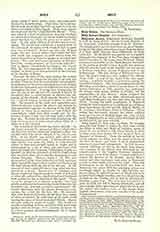

Holyrood Abbey, Edinburgh, Scotland, founded in 1128 by King David I for the Canons Regular of St. Augustine, probably brought from St. Andrews. The foundation is said to have been an act of thanksgiving for the king’s miraculous escape from the horns of a hart, whilst hunting near Edinburgh on Holy Cross day. In the church was preserved, in a golden reliquary, the fragment of the True Cross brought by David’s mother, St. Margaret, from Waltham Abbey, and known thereafter as the Black Rood of Scotland. At the battle of Neville’s Cross, in 1346, this precious relic fell into the hands of the English, and was placed in Durham Cathedral, whence it disappeared at the Reformation. The first Abbot of Holyrood was Alwyn, the king’s confessor, who resigned the abbacy about 1150. A seal of his, dated 1141, and representing a cruciform church, is preserved among the Newbottle Charters. The twenty-ninth and last Catholic abbot was Robert, a natural son of James V, who turned Protestant in 1559, married, and exchanged his abbacy with Adam, Bishop of Orkney, for the temporalities of that diocese. Adam resigned the abbacy in 1581 to his son John (afterwards created Lord Holyroodhouse), the last who bore the title of abbot. Among the chief benefactors of Holyrood during the four centuries of its existence as a religious house were Kings David I and II; Robert, Bishop of St. Andrews; and Fergus, Lord of Galloway. Twice during the fourteenth century the abbey suffered from the invasion of English kings: the army of Edward II plundered it in 1322, and it was burnt in 1385 by Richard II, but soon restored.
King James I’s twin sons, of whom the younger succeeded his father as James II, were born within the abbey in 1430, and Mary of Gueldres, queen of James II, was crowned in the abbey church in 1449. Twenty years later James III was married there to Margaret of Denmark. From the middle of the fifteenth century the abbey was the usual residence of the Scottish kings, and James V spent considerable sums on its repair and enlargement. In 1547 the conventual buildings, as well as the choir, lady chapel, and transepts of the church were destroyed by the commissioners of the English Protector Somerset, and twenty years later Knox’s “rascal multitude” sacked the interior of the church. Queen Mary’s second and third marriages took place at Holyrood, as well as other tragic events of her reign. From the Reformation to the Restoration little was done to Holyrood, but about 1670 the adjoining palace was practically rebuilt by Charles II. His Catholic successor, James II, ordered the nave of the church to be restored for Catholic worship, and as a chapel for the Knights of the Thistle; but he had to abandon his kingdom a year later. The nave roof was vaulted in stone in 1758, but fell in shortly afterwards, and all that remains of the once famous abbey church is now the ruined and roofless nave, of the purest Early English architecture, with some remains of the earlier Norman work.
D. O. HUNTER-BLAIR

